Staff clothing
BARRIER Medical face masks
Medical face masks designed to support infection control
BARRIER® Medical face masks are designed to minimise the transfer of bacteria and particles from medical personnel to the patient.
Your choice of medical face mask can make a difference. Our BARRIER medical face masks offer bacterial filtration, which reduces the risk of infection and the need for costly aftercare. Another important aspect of the medical face masks is comfort. BARRIER medical face masks are all designed to promote high comfort and low air resistance to reduce irritating the wearer.
- Designed to promote high comfort
- Wide range of designs, sizes and protection levels, to suit all needs
- All our medical face masks come with extra-long tie-bands
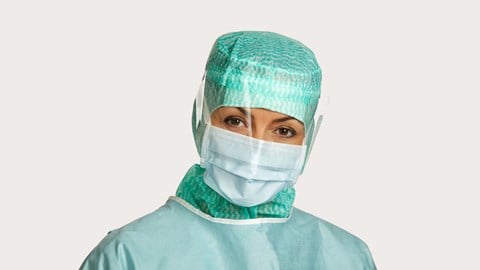
Medical face masks with extra protection. Most products in this assortment offer splash resistance, making them suitable for interventions with large amounts of fluid. Comes in a wide range of designs and with extra features for comfort and protection, such as anti-fog functions and visors.
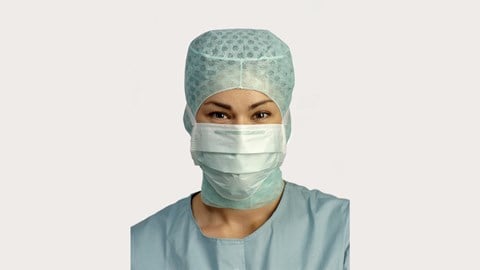
BARRIER Medical face masks – Assortment Special
Medical face masks with added comfort features. Comes in a wide range of designs and with extra features for comfort and performance such as anti-fog functions, anti-reflection, cup-keepers and comfort layers close to the skin.
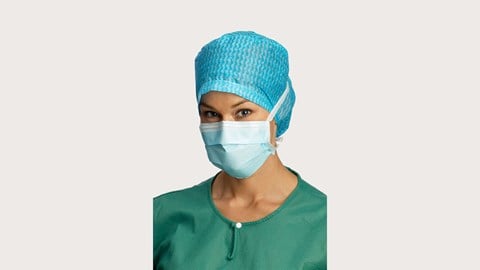
Our standard assortment of medical face masks offers high filtration capacity, limiting the spread of bacteria within the OR. And thanks to low breathing resistance, they are comfortable during long work shifts.
Medical face masks with EN 149 and A1:2009 filtration-compliance, providing protection from airborne particles. The assortment includes masks with different levels of filtration for different needs.
Further product information
When to use BARRIER Medical face masks
The BARRIER range of medical face masks can be used in wide range of situations. All our medical face masks offer high filtration capacity while retaining low breathing resistance and are classified as type II or IIR as per EN 14683. Choose products from our Extra protection assortment for interventions with large amounts of fluid or where splashes can occur.
Our products can of course also be used on patients and visitors to enable bacterial filtration in clinical settings.
How to use BARRIER Medical face masks
Downloads
- template-document-to-be-replaced.pdf (1000 kB)
Product details
| Code | Size cm | Pcs/box | Pcs/case |
Related products
'References'
 BARRIER medical face mask
BARRIER medical face mask


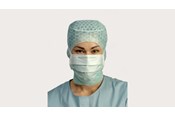
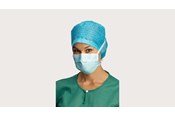
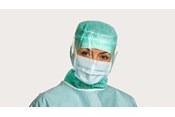
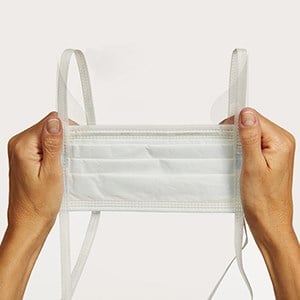 Before putting on the surgical mask, pre-fold the visor at the edges to achieve optimal protection from side splashes that could potentially come into contact with the eyes.
Before putting on the surgical mask, pre-fold the visor at the edges to achieve optimal protection from side splashes that could potentially come into contact with the eyes.
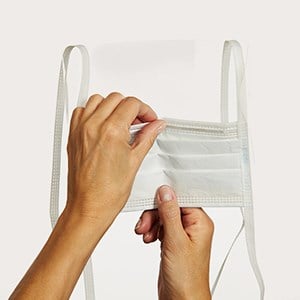 Pre-form the nose-clip.
Pre-form the nose-clip.
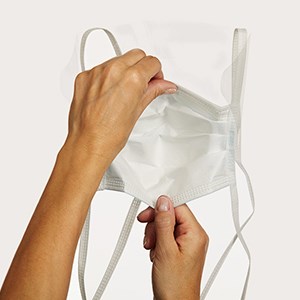 Pull the mask from the top and bottom to fully unfold the pleats of the surgical mask.
Pull the mask from the top and bottom to fully unfold the pleats of the surgical mask.
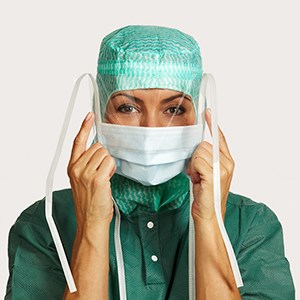 Place the surgical mask on your face making sure to cover your nose and mouth.
Place the surgical mask on your face making sure to cover your nose and mouth.
 Position the upper tie-bands at the crown of your head and tighten securely to minimize air leakage.
Position the upper tie-bands at the crown of your head and tighten securely to minimize air leakage.
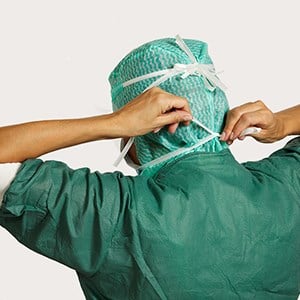 Position the lower tie-bands at the nape of your neck and tighten.
Position the lower tie-bands at the nape of your neck and tighten.
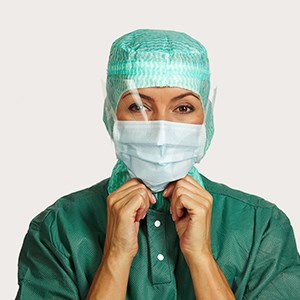 Always unfold the mask fully to minimize the number of layers you have to breathe through.
Always unfold the mask fully to minimize the number of layers you have to breathe through.
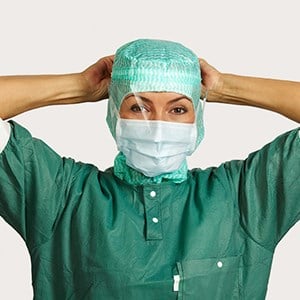 Change surgical mask when contaminated as well as between operations.
Change surgical mask when contaminated as well as between operations.
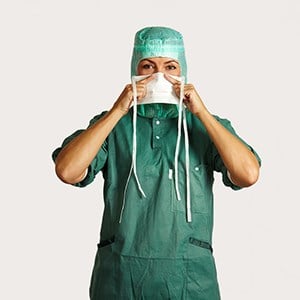 Pre-form the nose-clip. Place the surgical mask on your face making sure to cover your nose and mouth.
Pre-form the nose-clip. Place the surgical mask on your face making sure to cover your nose and mouth.
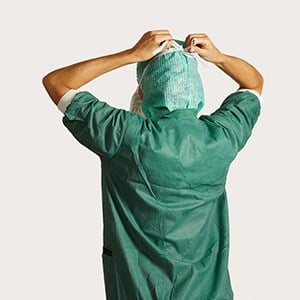 Position the upper tie-bands at the crown of your head and tighten securely to minimize air leakage.
Position the upper tie-bands at the crown of your head and tighten securely to minimize air leakage.
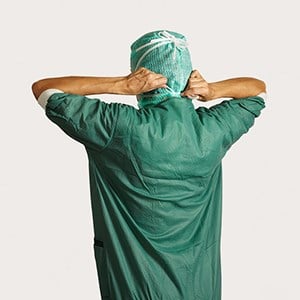 Position the lower tie-bands at the nape of your neck and tighten.
Position the lower tie-bands at the nape of your neck and tighten.
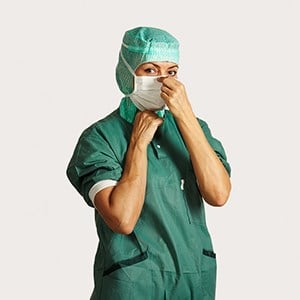 Always unfold the mask fully to minimize the number of layers you have to breathe through.
Always unfold the mask fully to minimize the number of layers you have to breathe through.
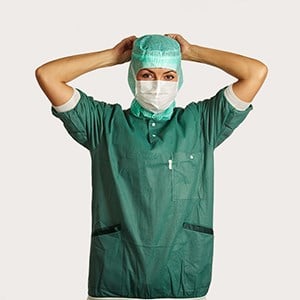 Change surgical mask when contaminated as well as between operations.
Change surgical mask when contaminated as well as between operations.
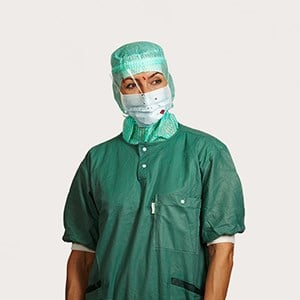 When there is a risk of fluid splashes use a splash resistant surgical mask and protective eyewear or a splash resistant surgical mask with a visor.
When there is a risk of fluid splashes use a splash resistant surgical mask and protective eyewear or a splash resistant surgical mask with a visor.
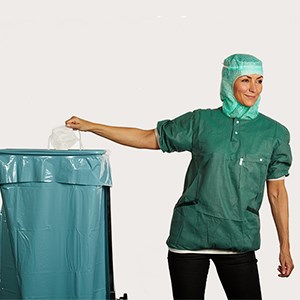
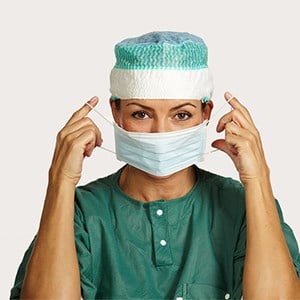 Put your fingers through the ear-loops. The nose clip should be positioned at the top. Place the mask over your nose and mouth.
Put your fingers through the ear-loops. The nose clip should be positioned at the top. Place the mask over your nose and mouth.
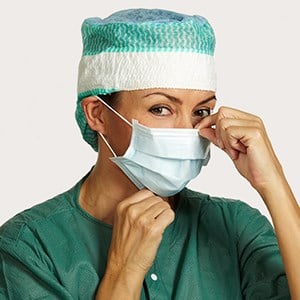 Position the ear-loops around the ears. Pull the mask from the top and bottom to fully unfold the pleats of the surgical mask. This will provide maximum coverage of the face and minimize the layers you have to breathe through.
Position the ear-loops around the ears. Pull the mask from the top and bottom to fully unfold the pleats of the surgical mask. This will provide maximum coverage of the face and minimize the layers you have to breathe through.
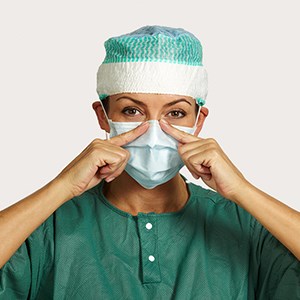 Form the nose clip over the bridge of the nose to minimize air leakage.
Form the nose clip over the bridge of the nose to minimize air leakage.
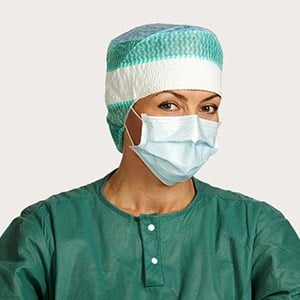 Ears and hair should be covered with an appropriate choice of headwear to minimize spread of hair and other particles. If there is a risk of fluid splashes ensure that you select a four layer splash resistant surgical mask. Change surgical mask when contaminated as well as between operations.
Ears and hair should be covered with an appropriate choice of headwear to minimize spread of hair and other particles. If there is a risk of fluid splashes ensure that you select a four layer splash resistant surgical mask. Change surgical mask when contaminated as well as between operations.
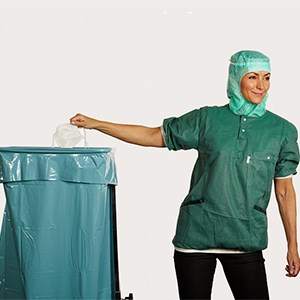 Dispose of the surgical mask after use.
Dispose of the surgical mask after use.




